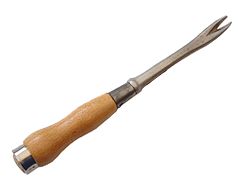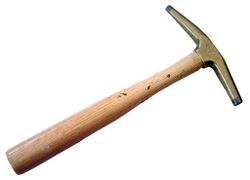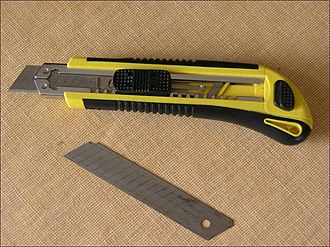Difference between revisions of "AY Honors/Upholstery/Answer Key"
JadeDragon (talk | contribs) |
JadeDragon (talk | contribs) |
||
| Line 116: | Line 116: | ||
===j. Back Tacking Strip. === | ===j. Back Tacking Strip. === | ||
==3. Name two types of material used for upholstery. == | ==3. Name two types of material used for upholstery. == | ||
| + | *Any of the fibres listed above | ||
| + | *leather | ||
| + | |||
==4. Explain how to fit the top cover to a lid. == | ==4. Explain how to fit the top cover to a lid. == | ||
==5. What is the name of the material used for the base of lounges and the base of your box etc., and what is its purpose? == | ==5. What is the name of the material used for the base of lounges and the base of your box etc., and what is its purpose? == | ||
Revision as of 13:47, 17 November 2018
Template:Honor desc Template:Honor Master
1. Know five of the following terms used in upholstery to describe the tools and give their uses:
a. Tack Claw
A tack claw is a tool used for pulling tacks out of furniture. One end has a handle by which the tool is gripped. The other end has a claw which is wedged underneath the head of the tack. The handle is then either lifted or pushed down, levering out the tack.
b. Staple Remover
A staple knocker is a tool resembling a screwdriver, used for removing staples and shredded material. It is called a knocker because a hammer can be used to hit the end of it and remove long lines of shorter staples.
c. Regulator, Mattress Needle
An upholstery regulator is an upholstery tool which smooths irregularities in the stuffing beneath the coverings.
While it looks similar to a needle it is heavier; like needles the regulator comes in various gauges and lengths. It is used to poke through the various layers to adjust the stuffing before the final cover is put in place.
A related tool is the stuffing iron, which is used to push the stuffing into the curves and corners of a piece of furniture; it has a narrow piece of steel with one toothed edge to grab loose stuffing and place it in the hard to reach spots. <br style="clear:both"
d. Magnetic Hammer
A magnetic hammer (also called a tack hammer or an upholstery hammer) is a lightweight hammer used for securing upholstery fabric to furniture frames using tacks.
One face of the hammer is magnetized to aid in placement of tacks. Once started, the tacks are driven with the other face. Staple guns have largely replaced tacking as an upholstery technique, except where decorative tacks are used. In the case of decorative tacks, the non-magnetic face of the hammer is often outfitted with a nylon tip so that the tack is not marred as it is driven in place.
e. Sharp Knife or “Snap” blade knife
A snap blade knife is a general-purpose utility knife used for cutting upholstery. When the tip becomes dull, the end of the blade can be snapped off, revealing a sharp, new tip. When the last tip is used, the knife can be refilled with a new blade.
Be careful to properly dispose of the snapped-off tips. They are still sharp enough to pose a danger to anyone who picks it up (either intentionally or not).
f. Work Table
A work table provides a surface to hold the work at a level that is comfortable for the upholsterer. It should be sturdy and stable.
g. Industrial Sewing Machine
An industrial sewing machine uses a much more powerful motor than a household sewing machine. It also operates much faster and makes more consistent stitches because the parts are precision machined. It is also an order of magnitude more expensive than a household sewing machine.
An industrial sewing machine is needed for upholstery because it is able to sew through heavy material that a household machine would have no hope of accommodating.
Because of its great speed and power, it is important to carefully read the instruction manual for the model of industrial sewing machine before using it. If no manual is available, contact the manufacturer for a replacement.
h. Sundry Items
Sundry items include:
- Tacks
- Tacks are used for holding upholstery fabric to the wooden frame of an item of furniture. They can be hidden, or they can be decorative.
- Staples
- Staples are much easier to use than tacks, and have largely replaced tacks where they are hidden (such as the underside of a chair or couch).
- Webbing
- Webbing is frequently used to form a base that supports a cushion. It is put in place with the aid of a web stretcher.
- Twine
- Rather than using thread, upholsterers use twine of various sizes. Number 5 twine is used to lash springs into place. Numbers 3 and 1 are smaller and are used for stitching fabric.
2. Explain the use of the following items:
a. Webbing
Webbing is used in couches and chairs as a base for the seating areas that is both strong and flexible. Many types of outdoor furniture use little more than thin light webbing for the seating areas. Webbing is also used to reinforce joints and areas that tend to flex.
b. Staples and Tacks
Staples and tacks are used for holding fabric in place. Staples are used only where they will be hidden. Tacks are used when the seam will be seen.
c. Hessian
Hessian (also called burlap) is a coarse cloth made of vegetable fibers. In upholstery it is used as an internal layer to hold batting in place. It is also used on the underside of furniture. Hessian is a very strong cloth and is used as a support cloth and as a liner.
d. Buttoning Cord or Waxed Flax
These items are used where very strong twine is needed, such as for holding buttons in place. The wax on the twine helps the twine stay in place as it is tightened.
e. Calico
Calico is a textile made from unbleached, and often not fully processed, cotton. It may contain unseparated husk parts, for example. The fabric is less coarse and thick than canvas or denim, but owing to its unfinished and undyed appearance, it is still very cheap.
f. Fibre
Fibre is the source material that the fabric is made from. The choice of upholstery fibre determines how a fabric will look and feel, wear, how care-intensive it will be, and the cleaning methods you’ll need to use to maintain the item. Many manufactured clothes are blends of fibres that combine the advantages of different fibres while yielding an interesting look and feel.
Fibres come from three major sources: Animal, Plant fibre, and Synthetic.
ANIMAL:
- Sheep's wool. Virgin wool is new, not recycled.
- Silk is produced by the silkworm
- More exotic sources like alpaca, camel, mohair, and so on.
- The wilderness tabernacle had goat hair curtains (Exodus 26:7, Exodus 36:14) a sturdy hardwearing fabric associated with poverty in the Bible, the Israelites were very familiar with goat hair cloth. (See Number 31:20) and even some modern Bedouin tents are made from goat hair. Click for more information on goat hair in the Bible. Goat hair points us to Jesus' humility and poverty. [1]
PLANT
- Cotton a soft, fluffy staple fiber that grows in a boll, or protective case, around the seeds of the cotton plant
- Linen remains the ofher popular plant based fibre. The tabernacle used "fine linen" a special fabric collected from the Egyptians at the Exodus made from flax. It was pure white and worn by Pharohs and nobility. Examples found in Egyptian tombs include some extremely fine samples including 152 threads per inch in the warp and 72 threads per inch in the woof. In the Bible white linen always speaks of purity and righteousness, pointing to Christ who is spotless, pure, and sinless. Jesus (Rev 3:5) and the angel armies (Rev 19:14) are seen in fine white linen.
SYNTHETIC
- Any of a variety of manufactured fabrics from chemical sources. Four synthetic fibres - nylon, polyester, acrylic and polyolefin - account for approximately 98 percent by volume of synthetic fiber production, with polyester alone accounting for around 60 per cent.
g. Flock
Flocking is a type of texture applied to a surface.
"Flocking" is a decoration process that enhances the way a wide variety of products are experienced by making ordinary surfaces seem far more magical and special. "Flocking" is the process of depositing millions of little individual cut fiber particles (called "flock") onto the surface of an article for the purpose of increasing its value in terms of the tactile sensation, aesthetics, color and appearance, and/or a wide variety of other functions--such as insulation, slip-or-grip friction, etc.
h. Foam Sheeting
Sold in rolls or sheets, poly foam is used to create soft seats and backs for furniture. It comes in various weights, thicknesses, softness and durability.
i. Glues
j. Back Tacking Strip.
3. Name two types of material used for upholstery.
- Any of the fibres listed above
- leather
4. Explain how to fit the top cover to a lid.
5. What is the name of the material used for the base of lounges and the base of your box etc., and what is its purpose?
6. Name two methods of attaching covers to chairs.
7. Complete a or b:
a. Ottoman
b. Toybox
8. Complete a Feature Panel.
Upholstered wall panelling can be an attractive additon to your decor and a functional piece of art. Fabric panels offer acoustic benefits as they absorb sound and tend to soften the look of the room. The use of different shapes, and the wide variety of fabric colours and textures available give unlimited possible combinations.
A feature panel can be purely decretive art or practical such as a pin board or headboard for a bed. A large example might cover an entire wall.
To create a feature panel you will need a plywood back, some foam (usually), and one or more fabrics. You may want to sew designs into the fabric or piece (quilt) pieces together. Attach the fabric and foam to the board around the back with staples and from the front with decorative tacks. This is a chance to be creative and have fun. It does not matter exactly what design you build, as long as the workmanship is good.
References
- Upholstery: A Complete Course : Chairs, Sofas, Ottomans, Screens and Stools By David James, published by Sterling Publishing Company, Inc., 1999; ISBN 1861081189, 9781861081186
- Furniture Upholstery for Schools is a book published in 1919. It is now in the public domain.




